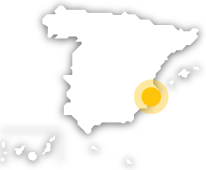Alicante celebrates the arrival of summer with the bonfires of San Juan. In a spectacular display of music, colour and fireworks, thousands of people throng the streets to experience this fiesta which pays tribute to fire.
To celebrate the arrival of summer, Alicante residents traditionally went to dinner in the countryside on June 23: they ate traditional food, and when midnight arrived, they lit bonfires, danced around them, launched rockets and swam in the sea. This custom endured over the years, and in 1928 the fiestas of the Bonfires of San Juan were formally constituted.
For several days, Alicante celebrates this great tribute to fire, in which the main protagonists are authentic works of ephemeral art: the hogueras, the enormous cardboard and wooden figures that are burned on the night of San Juan.The queen of the fiesta, known as the bellea del foc (the Beauty of the Fire), is chosen in May from among the candidates presented by a committee in each neighbourhood. The festivities officially begin with the plantà, or building, of enormous bonfires with their tongue-in-cheek cardboard figures which fill the streets of Alicante with wit and good humour. That day, the barracas or large tents are also put up to serve as a public dance floor, and these are where fiesta-goers can sample the typical figs and cocas (a kind of pastry with tuna, onions and pine nuts).Among the most representative acts of the festival are the Entrance of Bands and Commissions, with their respective “beauties” and bridesmaids dressed in traditional costumes; the floral offering to the city's patron saint, the Virgen del Remedio, on June 21 and 22; and the international folk parade, a colorful parade in which dance groups from all over the world participate. Also, every day at two in the afternoon from June 19 to 24, fireworks shows are held in the Plaza de los Luceros: They are the noisy “mascletàs”, which should be attended with earplugs, given the noise caused by gunpowder and rockets.Finally, at midnight on the night of 24 to 25 June comes the cremà (burning), the high point of the fiestas. After a spectacular white palm tree of fireworks, the bonfires all over the city are set alight and blaze away amid much merriment and dancing and singing, while fire-fighters shower the merrymakers with water in what is known as thebanyá.However, the party is not over yet. From 25 to 29 June, there is a fireworks competition on El Postiguet beach, and the historic centre of the town comes alive with a medieval market and a range of shows.



